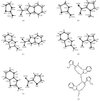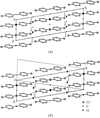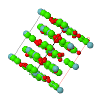issue contents
October 1999 issue

Cover illustration: An infinite hydrogen-bonded sheet in guanidinium trifluoromethanesulfonate. Courtesy of C. B. Aakeröy [Acta Cryst. (1997), B53, 569-586; structure determined by V. A. Russell, M. C. Etter & M. D. Ward].
lead articles
A crystal-chemical and topographical analysis is applied to vanadium oxide frameworks, in which a structural classification and a symbolic formula is suggested based on the variety of V coordination polyhedra and their one- and two-dimensional formations. Combinatorial deduction of possible structures is performed for the most common framework types.
research papers
The structural units based on anion-centered metal tetrahedra are considered as metal fragments with anions (usually O, N) inserted into tetrahedral interstices.
Download citation


Download citation


The crystal structure of moganite-type PON has been refined. This structure and those of moganite (SiO2) and orthorhombic BeH2 are shown to belong to a common group of twinned-quartz-based structures.
Download citation


Download citation


The utility of total neutron scattering in determining both the average and local structure in a disordered crystalline material is demonstrated for the lanthanum molybdate LaMo2O5. The compound contains the rare Mo—Mo bonded isolated Mo6O18 cluster and a new type of Mo—Mo bonded sheet.
The Coulomb field of the ionic model partitions itself into bond-like fragments, whose flux is equal to the bond valence.
Download citation


Download citation


The structure of RbTiOAsO4 (RTA) obtained from X-ray diffraction data at 9.6 K shows that there is no phase transition down to this temperature. The significant shifts of the Rb atoms from their room-temperature positions, and dipole-like electron density deformations near the Ti atoms along the polar c axis, indicate that these atoms contribute to the spontaneous polarization of RTA.
Download citation


Download citation


The structure of the orthorhombic phase of Cu8GeS6 has been refined on the basis of X-ray diffraction data from a 12-fold twinned crystal applying a six-dimensional twin refinement technique.
Download citation


Download citation


In the fluorite-related cubic structure of yttria-stabilized zirconia, Zr0.758Y0.242O1.879, studied with synchrotron radiation, Zr atoms are displaced from the origin of the space group Fm3¯m along 〈111〉 by 0.19 Å, while Y atoms reside at the origin.
Different statistical techniques show strong correlation among structural parameters describing YAG structures. The degree of correlation depends on doping site and garnet type. Structural parameters are not equally sensitive to changes imposed by doping.
Three different tests on twinning by merohedry from the literature have been applied to single crystal data sets of five different inorganic compounds. The efficiency of the procedures in both detecting the existence of twinning and estimating the volume fractions are compared.
Download citation


Download citation


Results from the structure determinations are in contradiction to a previously suggested mechanism for the anomalous physical properties of the title compound.
Download citation


Download citation


The structures of five adduct complexes of 2-aminothiazole derivatives with carboxylic-acid-substituted heterocycles all display a similar hydrogen-bonding network which involves an  graph set interaction between the component molecules. An interaction from the second 2-amino proton completes the hydrogen-bonding network.
graph set interaction between the component molecules. An interaction from the second 2-amino proton completes the hydrogen-bonding network.
Download citation


Download citation


Molecular dimensions, and electron and nuclear densities at very low temperatures indicate that the cis-enol ring of benzoylacetone has a delocalized structure with the enol hydrogen located in a single, approximately flat-bottomed potential well between two almost equivalent O atoms.
Hydrogen-bond networks of a dimorphic pair of 1β,3β,11α-trihydroxyspirosta-5,25(27)-diene monohydrate compounds, which have similar binary layer structures, are compared. They can be derived from each other by rotating water molecules, but without a major alteration of the relative arrangement of the heavy atoms involved.
Download citation


Download citation


Three crystal structures of 3-azabicyclononanes were determined from X-ray diffraction methods. The conformation, molecular geometry and packing mode of these structures are presented.
Download citation


Download citation


The nature of the structural phase transitions near 190 K in 4,4′-dichlorobenzophenone has been studied, using the temperature dependence of the lattice parameters and of the intensities of some reflections. The displacement-type transformation between the high-temperature C2/c and low-temperature I2/c phases occurs through an intermediate state, which is reached from above and below via two first-order phase transitions. The intermediate phase is partially disordered.
short communications
The redistribution of electron density within the azido unit in covalently bonded organic azides is responsible for decreasing its capacity for hydrogen bonding.
book reviews
Free 



 journal menu
journal menu



































